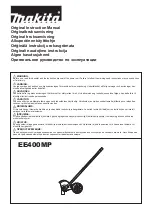
Page
7
of
12
INSTRUCTION
MANUAL
Shielded
T
‐
series
Coupling/Decoupling
Networks
(CDN)
19121
El
Toro
Rd
●
Silverado,
California
92676
●
(949)
459
‐
9600
●
com
‐
power.com
REV021215
5.0
CDN
Requirements
5.1
Overview
Com
‐
Power
shielded
CDN
‐
T
series
Coupling/Decoupling
Networks
are
designed
specifically
for
conducted
immunity
testing
per
IEC
61000
‐
4
‐
6.
The
shielded
CDN
‐
T
series
is
used
for
shielded
ethernet
lines
10/100/1000
mbps.
These
CDNs
•
Provide
a
means
of
coupling
RF
common
mode
signals
to
the
above
line
types.
•
Provide
the
required
common
mode
impedance
between
the
these
lines
and
ground
necessary
for
proper
performance
of
the
testing.
impedance
to
the
equipment
under
test
independent
of
the
auxillary
equipment
common
mode
impedance.
•
Minimize
interference
to
the
auxillary
equipment
via
common
mode
decoupling
of
the
disturbing
signals.
•
Provide
uninterrupted
communinication
between
the
EUT
and
auxillary
equipment.
The
Com
‐
Power
shielded
CDN
T
series
fully
comply
with
the
requirement
contained
in
the
IEC
61000
‐
4
‐
6
and
CISPR
16
‐
1
‐
2.
5.2
CDN
Parameters
5.2.1
Common
Mode
Impedance
Common
mode
impedance
is
defined
as
the
“ratio
of
common
mode
voltage
and
common
mode
current
at
a
certain
point“.
The
common
mode
impedance
requirements
for
a
CDN
must
be
met
with
CDN
auxillary
equipment
input
power
terminals
open
or
short
circuited
to
ground.
5.2.2
Voltage
Division
Factor
Voltage
division
factor
is
the
amount
of
voltage
that
is
lost
between
the
RF
input
terminal
of
the
CDN
and
the
EUT
port
and
is
measured
through
a
150
Ω
to
50
Ω
adapter
(ADA
‐
515)
connected
to
the
EUT
port.
5.2.3
Coupling
Factor
The
CDN
coupling
factor
is
defined
as
the
ratio
given
by
the
open
circuit
voltage
(e.m.f)
obtained
at
the
EUT
port
of
the
coupling
(and
decoupling)
device
divided
by
the
open
circuit
voltage
obtained
at
the
test
generator.






























